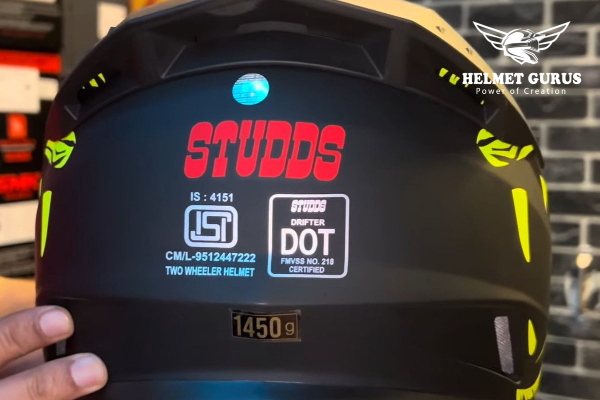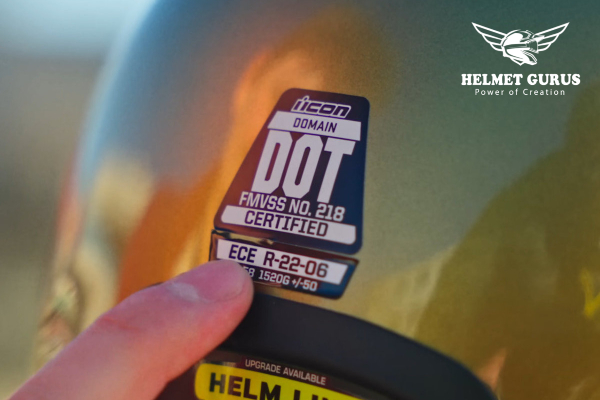There are both genuine DOT-approved helmets and their fake versions. And you can only count on the safety protection of authentic DOT-certified helmets.
Sadly, not everyone has the skills to identify the original DOT symbol and certifications. The post highlights the benefits of choosing DOT-certified helmets and how to identify models that attained the DOT motorcycle helmet safety standards.
What are DOT-Approved Helmets?
Every country has its minimum safety set standards for helmets. In the US, all helmets manufactured or used within the country must comply with the DOT set standard. DOT means Department of Transportation, as per FMVSS No 218.
Motorcycle riders must have at least DOT-approved motorcycle helmets. Therefore, a DOT approved helmet means it has passed the benchmark set standards for the FMVSS 218, federal motor vehicle safety standards.
The Importance of DOT-Approved Helmets
When shopping for a helmet blindly. Instead, settle on at least a DOT-certified helmet. Insisting on DOT approved helmet bestows numerous safety benefits:
Dot certified helmet has a sturdy shell and cushioning materials that absorb a significant amount of impact energy to save your head during a crash. And research suggests that helmets reduce the chances of a motorist’s death by a significant amount.
The basic motorcycle helmet safety tip requires that the hood offers optimum visibility, hearing, and concentration. Only a certified helmet from a reputable body (for example DOT) gives such benefits.
A DOT-quality helmet has the essential parts that enable it to fit securely and therefore feel comfortable. As a result, you won’t feel any part pricking on your head or require constant adjustment.
Being DOT certified you can count on the materials and workmanship of the hood. Hence such equipment is more likely to last longer than a helmet that doesn’t meet DOT standards.
How DOT certification enhances rider safety

The best DOT helmets enhance the rider’s safety since it has undergone and passed rigorous testing. The demanding tests assimilate various accident scenarios and various aspects of the helmet in multiple ways.
The criteria include the following:
Impact attenuation
In this test, a dummy head wearing a helmet is subjected to two successive drop impacts of not exceeding peak accelerations of 400g. The impact tests all four sides of the helmet against a hemispherical and flat steel anvil.
To pass the test, peak accelerations exceeding 200g must register an accumulated duration not exceeding 2.0 milliseconds. Similarly, accelerations of more than 150 g shouldn’t give accumulated durations of more than 4.0 milliseconds.
Penetration tests
In this case, a weight of about 6 lbs is dropped onto the dummy head figure form and helmet from a 10 feet 10 inches height. In the test, the striker must not make contact with the helmet at any point higher than the test line.
Retention test
The purpose of the retention tests is to verify the stability and strength of the helmet. In this case, the manufacturer subjects the head form to a simulated immovable tensile load.
If the retention assembly doesn’t separate and the adjustable part moves no more than 2.5 cm, the helmet has passed the test.
Identifying a DOT-Approved Helmet
In the current world most genuine products have their counterfeits. Thus, it’s vital to know the best way of identifying products that have met DOT helmet safety standards. You can easily identify fake DOT certifications by scrutinizing the manufacturer’s labeling details and DOT symbol.
Tips for Verifying DOT Approval
The unsuspecting mind may easily fall victim to counterfeit Dot approvals. However below are practical steps on how to unmask such fake DOT approvals:
DOT Symbol and Location
You can easily spot a genuine DOT helmet certification mark on the exterior back of the helmet. such a symbol should be permanent, highly legible, and not masked by any decal.
Manufacturer’s information
Inside the helmet, you’ll get detailed, accurate, and legible information such as:
- Manufacturer name, month, and year
- Helmet size
- Model designation
- Information on how to use and care for the helmets
Choosing the Right DOT Approved Helmet
When choosing the right DOT-certified helmet, there are critical factors that you have to take into account. For instance, you need to consider the local motorcycle helmet laws and personal preference.
If you need comprehensive head coverage the full-face DOT approved helmet wins. Further, the helmet that you choose must reflect the size of your head and have plenty of ventilation.
Besides, draw out and budget and identify a helmet brand and fit that suits you.
Different Types of DOT-Approved Helmets
DOT-certified helmets come in various types and suit diverse riding styles.
Top on the list are full-face helmets that provide comprehensive coverage of the head, face chin, and jaws. Whether undertaking long or daily commuting, full-face DOT-certified helmets offer top-notch protection. Though some claim it suffocates them.
Open-face helmets as the name implies don’t cover the entire head. Instead, it leaves the chin and jaw areas exposed. Owing to their lightweight, comfort, and ventilation most people prefer them for short rides. Besides, it suits hot weather and low-speed ride settings due to its low safety level.
DOT-approved modular helmets combine the features of open and full face. Its dual purpose makes it ideal for adventurers and tourers. Its level of protection and cost is slightly lower than the full-face helmets.
Half helmets on the other hand protect the head only. It leaves your ears, jaw, neck, and chin bare to the risk of injuries. But it offers lightweight, high visibility, low storage space, and costs less.
Dual sports helmets have a chin guard fixed to the shell and a visor that you can flip up at will. Owing to that improvement they fit rides at moderate speed and adventures at soft roads.
Conclusion
You must choose genuine DOT approved helmets. Such helmets have undergone and passed demanding tests regarding their retention, penetration, and impact attenuation tests. The Dot-certified helmets have adhered to the safety compliance standards. Therefore, you can count on their protection ability as compared to uncertified pieces of equipment.


Related Posts
Top 10 Best Modular Helmet: The Practical Balance Between Breathability and Safety Problems
The best modular helmet provides the benefits of both worlds. It’s a versatile helmet that adapts to various settings. While [...]
Best Scorpion Modular Helmets For Safe Adventure Rides
Scorpion has been in the helmet industry for over a century. Therefore, you can count on the safety and comfort [...]
Best Flip-up Helmet : TOP Recommendations From Experts
The best flip-up helmet adds versatility and convenience and hence makes every tour ride enjoyable. However, it doesn’t have to [...]
What Is a Modular Helmet? Everyone Wants to Know!
As a motorcycle rider, you should know what is a modular helmet since it may just be what you need. [...]